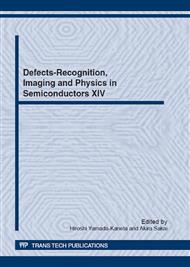[1]
G. Coletti, P. C. P. Brounsveld, G. Hahn, W. Warta, D. Macdonald, B. Ceccaroli, K. Wambach, N. L. Quang, and J. M. Fernandez, Adv. Funct. Mater, 21, 879, (2011).
DOI: 10.1002/adfm.201000849
Google Scholar
[2]
B. Sopori, "Impurities and Defects in Photovoltics Si Devices", 10th international Work shop on the physics of semiconductor devices, (1999).
Google Scholar
[3]
A. A. Istratov, T. Buonassisi, M. D. Pickett, M. Heuer, and E. R. Weber, Mater. Sci. Eng. B, 134, 282 (2006).
Google Scholar
[4]
J. Lu, M. Wagener, and G. Rozgonyi, J. Appl. Phys., 94, 140 (2003).
Google Scholar
[5]
M. Kittler, C. Ulhaqbouillet, and V. Higgs, J. Appl. Phys., 78, 4573 (1995).
Google Scholar
[6]
S. Kumari, N. K. Arora and G. C. Jain, Solar Energy Materials, 5, 383 (1981).
Google Scholar
[7]
Y. Ohshita, Y. Nishikawa, M. Tachibana, V. K. Tuong, T.Sasaki, N. Kojima, S. Tanaka, and M. Yamaguchi, J. Cryst. Growth, 275, e4 91 (2005).
Google Scholar
[8]
J. Chen, T. Sekiguchi, R. Xie, P. Ahmet, T. Chikyow, D. Yang, S. Ito, and F. Yin, Scr. Mater., 52, 1211 (2005).
Google Scholar
[9]
K. Arafune, E. Ohiishi, H. Sai, Y. Terada, Y. Ohshita, and M. Yamaguchi, Jpn. J. Appl. Phys., 45, 6153 (2006).
Google Scholar
[10]
T. Tachibana, J. Masuda, K. Imai, A. Ogura, Y. Ohshita, K. Arafune, and M. Tajima, Jpn. J. Appl. Phys., 48, 121202 (2009).
DOI: 10.1143/jjap.48.121202
Google Scholar
[11]
J. Chen and T.Sekiguchi, Jpn. J. Appl. Phys., 46, 6489 (2007).
Google Scholar
[12]
J. Chen, T. Sekiguchi, S. Nara, and D. Yang, J. Phys.: Condens. Matter, 16, S211, (2004).
Google Scholar
[13]
A. A. Istratov, H. Hieslmair, and E. R. Weber, Appl. Phys. A: Mater. Sci. Process, 69, 13 (1999).
Google Scholar
[14]
A. A. Istratov, P. Zhang, R. J. McDonald, A.R. Smith, M. Seacrist, J. Moreland, J.shen, R. Wahlich, and E. R. Weber, J. Appl. Phys., 97, 023505 (2005).
DOI: 10.1063/1.1836852
Google Scholar
[15]
F. Secco d'Aragona, J. Electrochem. Soc., 119, 948 (1972).
Google Scholar
[16]
T. Buonassisi, A. A. Istratov, S. Peters. C. Ballif, J. Isenberg, S. Riepe, W. Warta, R. Schindler, G. Willeke, Z. Cai, B. Lai, and E. R. Weber, Appl, Phys. Lett., 87, 121918 (2005).
DOI: 10.1063/1.2048819
Google Scholar
[17]
W. T. Read and W. Shockley, Phys. Rev., 78, 275 (1950).
Google Scholar
[18]
S. M. Sze and J. C. Irvin, Solid-State Electronics, 11, 599 (1968).
Google Scholar



